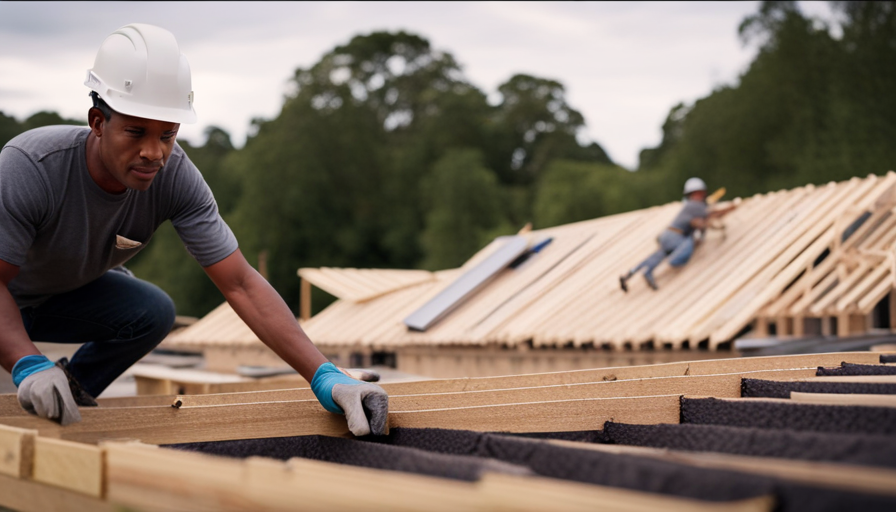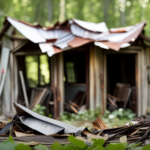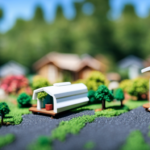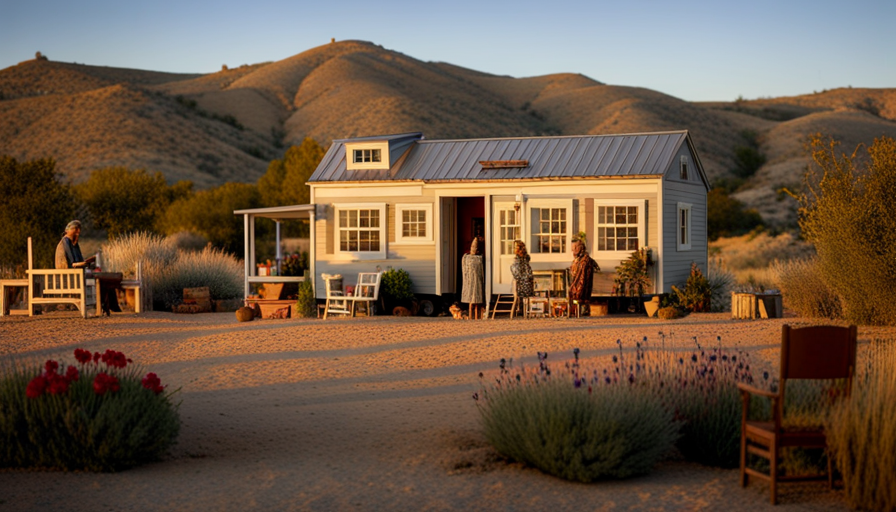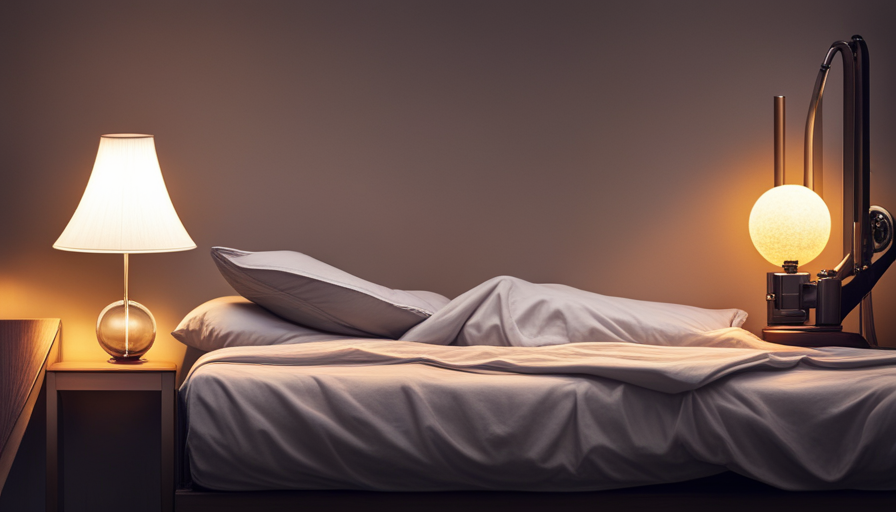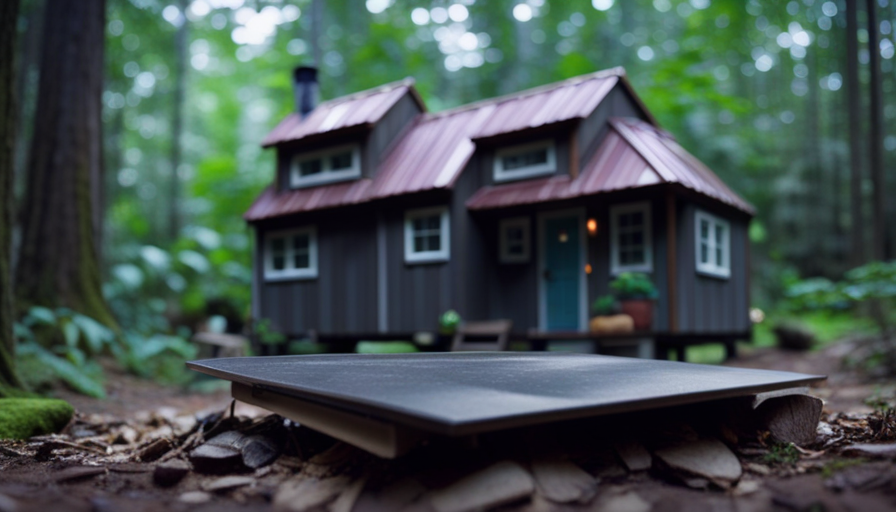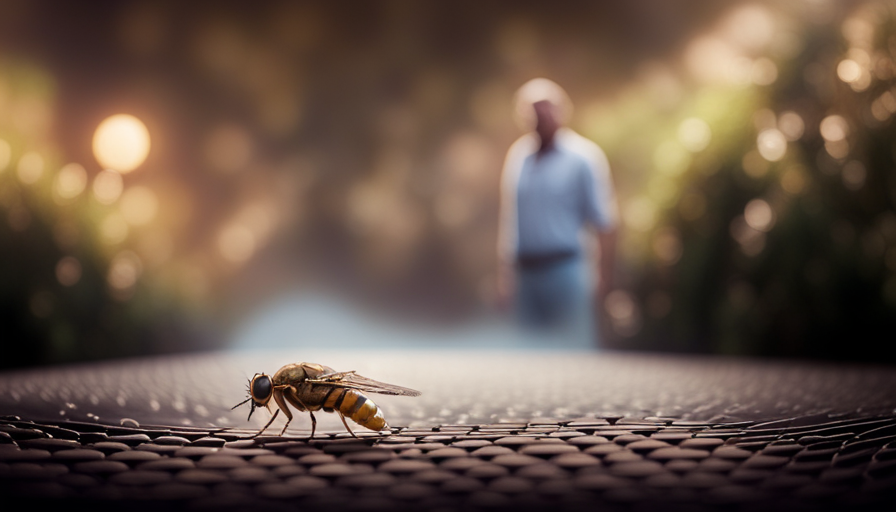In the vast world of reality television, Tiny House Nation stands out uniquely, similar to a small home in a forest of tall skyscrapers.
This captivating series takes us on a journey into the world of minimalistic living, where homeowners trade in their spacious dwellings for a life of simplicity and efficiency.
But what happens to these brave souls after the cameras stop rolling? How are they faring in their petite abodes, surrounded by only the bare essentials?
In this article, we embark on a quest to uncover the truth behind the tiny house movement. Through a lens that is both objective and analytical, we delve into the experiences of these individuals, exploring their financial considerations, unique living experiences, and the emotional impact of downsizing.
Join me as we uncover the lessons learned, the challenges faced, and ultimately, the happiness and fulfillment that can be found in living tiny.
Key Takeaways
- Participants in the Tiny House Nation show have achieved personal goals such as financial freedom, career advancement, and sustainable living.
- Going tiny can be a catalyst for personal growth and fulfillment.
- Downsizing living space allows individuals to save money and live a more sustainable lifestyle.
- Living in a tiny house forces individuals to prioritize what truly matters to them and focus on experiences and relationships.
The Journey to Going Tiny
You’re embarking on a thrilling journey as you make the decision to downsize and join the tiny house movement. The decision process of transitioning to a tiny house involves careful consideration of your current lifestyle and future goals.
It requires evaluating your needs versus wants and prioritizing what truly matters to you. Adjusting your lifestyle to fit into a tiny house can be challenging but also rewarding. It means letting go of excess possessions and learning to live with less.
It involves finding creative solutions for storage, maximizing space, and embracing a simpler way of life. As you delve into the world of tiny house living, you’ll discover the freedom and fulfillment that comes with a minimalist lifestyle.
Transitioning from a traditional home to a tiny house opens up a world of possibilities and a chance to live more intentionally.
Life in a Tiny House
Living in these small abodes, it’s like inhabiting a cozy shoebox where every nook and cranny has a purpose. The minimalist lifestyle embraced in tiny house living encourages us to question our attachment to material possessions and focus on what truly matters. Space optimization becomes a way of life, with multifunctional furniture and clever storage solutions. It’s amazing how much functionality can be packed into such a small space.
Let me illustrate this with a table:
| Column 1 | Column 2 | Column 3 |
|---|---|---|
| Kitchen | Living Area | Bedroom |
| Compact appliances and efficient layout make cooking a breeze. | Comfortable seating area for relaxation and entertainment. | A lofted bed maximizes floor space during the day. |
Living in a tiny house allows us to appreciate the simple joys of life and forces us to prioritize what truly matters. As we delve into the financial considerations of this lifestyle, it becomes evident that the benefits extend beyond just a smaller mortgage.
Financial Considerations
When it comes to the financial side of things, it’s important to consider the long-term cost savings that come with embracing the tiny house lifestyle.
Budgeting becomes a key aspect of this way of living, as it allows individuals to have a clear understanding of their expenses and prioritize accordingly.
With a smaller space, there is less room for unnecessary purchases, which can lead to financial freedom and a more intentional way of living.
Additionally, the reduced size of a tiny house often means a smaller mortgage or even no mortgage at all, resulting in significant savings.
This financial flexibility allows people to pursue their passions, travel, or invest in experiences rather than material possessions.
Transitioning into the subsequent section about unique living experiences, it’s fascinating to see how these financial considerations can greatly impact one’s overall quality of life.
Unique Living Experiences
When it comes to unique living experiences in tiny houses, two key points come to mind. One is the sense of community and connection in tiny house communities. Living in a tiny house community offers the opportunity to connect with like-minded individuals who share a similar lifestyle and values, fostering a strong sense of community.
The other key point is the freedom of travel and mobility with a tiny house on wheels. Having a tiny house on wheels allows for the flexibility to travel and explore different places. This provides a unique and ever-changing living experience.
Community and Connection in Tiny House Communities
To truly thrive in tiny house communities, it’s essential that you foster a sense of community and connection with your neighbors. Community building is at the heart of these living experiences, and it’s through support networks that residents find a sense of belonging and security.
In these communities, neighbors not only share physical space but also support one another emotionally and socially. This creates a tight-knit community where everyone knows and looks out for each other. Furthermore, these communities often organize events and activities that encourage interaction and strengthen the bonds between neighbors. From potluck dinners to communal gardening, there are plenty of opportunities for residents to come together and build lasting connections.
Transitioning into the next section, travel and mobility with a tiny house on wheels allows individuals to experience different communities and expand their support networks even further.
Travel and Mobility with a Tiny House on Wheels
If you want to truly expand your horizons and broaden your sense of community, consider the freedom and opportunities that come with traveling and living in a tiny house on wheels. Not only does it allow you to explore different places and cultures, but it also promotes sustainability as you minimize your carbon footprint. However, there are challenges that come with traveling and living in a tiny house on wheels. The limited space can make it difficult to store essentials and maintain a comfortable living environment. Additionally, finding suitable parking and dealing with zoning regulations can be a hassle. Despite these challenges, there are solutions available. Utilizing clever storage solutions and researching local laws and regulations beforehand can help overcome these obstacles. Ultimately, living a nomadic lifestyle in a tiny house on wheels offers a unique and adventurous experience. Transitioning into the emotional impact, it’s important to acknowledge the profound effect this lifestyle can have on individuals.
The Emotional Impact
You can’t underestimate the emotional rollercoaster that the participants on the Tiny House Nation show experience. Living in a tiny house on wheels undoubtedly has its challenges, and these challenges can take a toll on one’s emotional well-being and mental health.
The constant need to adapt to a small living space, the limited privacy, and the potential for isolation can all contribute to feelings of frustration, stress, and even loneliness. However, it’s important to note that the emotional impact is not solely negative. Many participants also experience a sense of freedom, simplicity, and fulfillment in their tiny house lifestyle. It’s a mixed bag of emotions, with highs and lows.
Ultimately, the emotional journey of living in a tiny house teaches us valuable lessons about resilience, adaptability, and the importance of finding contentment in simplicity.
Lessons Learned
The participants on Tiny House Nation have undoubtedly learned valuable lessons about resilience and adaptability through their emotional journey. As they navigate the challenges of downsizing their living spaces and adjusting to a simpler lifestyle, they’re forced to confront their own attachments to material possessions and re-evaluate their priorities.
Through this process, they’ve learned that happiness and fulfillment don’t necessarily come from having a large house filled with stuff, but rather from cultivating meaningful relationships, pursuing personal passions, and finding joy in the little things. This journey has led to immense personal growth, as they’ve discovered their own strengths and capabilities and learned to overcome obstacles with a positive mindset.
These lessons will undoubtedly continue to shape their lives long after the cameras stop rolling.
Transitioning into the subsequent section about ‘finding happiness and fulfillment’, the participants haven’t only learned important lessons, but they’ve also embarked on a transformative journey towards finding true happiness and fulfillment.
Finding Happiness and Fulfillment
One of the key points in the discussion on finding happiness and fulfillment in the tiny house movement is the success stories and achieving personal goals. Many individuals who’ve transitioned to tiny living have shared their stories of how they were able to achieve their goals, whether it’s financial freedom, a simpler lifestyle, or a stronger sense of community. It’s inspiring to hear how people have found happiness and fulfillment by taking the leap into tiny living.
Another aspect to consider when reflecting on the overall impact of going tiny is the profound effect it has on individuals’ lives. By downsizing and simplifying their living spaces, people have been able to focus more on what truly matters to them, leading to a greater sense of happiness and fulfillment. The shift in mindset and lifestyle that comes with going tiny has the potential to bring about positive changes in various aspects of one’s life.
Overall, the success stories and the overall impact of going tiny show that finding happiness and fulfillment is possible through this lifestyle choice. It’s a testament to the power of simplicity, intentionality, and aligning one’s life with their values. The tiny house movement offers a unique opportunity for individuals to redefine success and find true happiness on their own terms.
Success Stories and Achieving Personal Goals
Since appearing on Tiny House Nation, many individuals have spread their wings and soared to great heights, achieving personal goals they once thought were as distant as the stars. The success stories are abundant and inspiring, showcasing the power of determination and self-improvement.
Here are a few examples:
-
Financial Freedom: Several participants have successfully paid off their debts and achieved financial stability by downsizing their lives and embracing a minimalist lifestyle.
-
Career Advancement: By reducing their living expenses and eliminating the need for a large salary, some individuals have been able to pursue their dream careers or start their own businesses.
-
Sustainable Living: Many have used their tiny homes as a platform to promote eco-friendly living, adopting sustainable practices and inspiring others to do the same.
These achievements prove that going tiny can be a catalyst for personal growth and fulfillment. Reflecting on the overall impact of going tiny, it’s clear that it has transformed lives in ways previously unimaginable.
Reflection on the Overall Impact of Going Tiny
After hearing about the success stories and how people have achieved their personal goals through going tiny, I can’t help but reflect on the overall impact it has had on their lives.
It’s fascinating to see how downsizing their living space has not only allowed them to save money and live a more sustainable lifestyle, but also positively impacted their emotional well-being and personal satisfaction.
Living in a tiny house has forced them to prioritize what truly matters to them, letting go of material possessions and focusing on experiences and relationships instead.
This shift in mindset has brought them a sense of freedom and contentment that they didn’t expect.
It’s clear that going tiny has not only transformed their physical living space, but also their inner world, leading to a more fulfilling and meaningful life.
Frequently Asked Questions
How can I apply to be on the Tiny House Nation show?
To apply for the Tiny House Nation show, the first step is to visit the official website and fill out an application form.
The application process typically involves providing personal information, an explanation of why you want to be on the show, and details about your tiny house project.
The selection criteria may include factors like uniqueness of design, interesting story, and feasibility of the project.
The producers carefully review applications to choose participants who best fit the show’s criteria.
What is the average cost of building a tiny house?
Building a tiny house can be a daunting task, especially when it comes to the cost analysis and budget planning. However, with careful planning and research, it’s possible to keep expenses under control.
The average cost of building a tiny house ranges from $20,000 to $100,000 depending on various factors such as size, materials used, and location. By making smart choices and prioritizing your needs, you can create a cozy and affordable tiny home that fits your lifestyle and budget.
Are there any zoning or legal restrictions for living in a tiny house?
Zoning restrictions and legal issues can pose challenges for those wanting to live in a tiny house. Many municipalities have specific regulations regarding minimum square footage, setbacks, and building codes that may not align with the tiny house lifestyle.
Additionally, some areas may not allow tiny houses as primary residences or require them to be located in designated communities. It’s important to research and understand local zoning laws and consult with legal professionals to ensure compliance and avoid any legal complications.
What are some common challenges faced by people living in tiny houses?
Common challenges faced by people living in tiny houses include financial constraints and space limitations. Financial constraints can make it difficult to afford the initial cost of a tiny house, as well as ongoing expenses such as maintenance and utilities.
Space limitations can lead to issues with storage and organization, as well as a lack of privacy. However, many people find creative solutions to these challenges and enjoy the benefits of a simpler, more sustainable lifestyle.
Are there resources available to help with downsizing and decluttering before moving into a tiny house?
Downsizing and decluttering before moving into a tiny house can be overwhelming. However, there are plenty of resources available to help make the process easier.
From downsizing tips to minimalist living tips, these resources offer practical advice and strategies to simplify your life.
Embracing a minimalist lifestyle can be liberating and rewarding, allowing you to focus on what truly matters.
Remember, it’s not just about the physical stuff, but also about creating a mindset of simplicity and intentionality.
Conclusion
In conclusion, the individuals featured on the Tiny House Nation show have embarked on a remarkable journey towards simplicity and minimalism.
Their lives in these compact spaces have not only brought financial considerations to the forefront but also unique living experiences and a profound emotional impact.
Through their stories, we’ve learned valuable lessons about finding happiness and fulfillment in unconventional ways.
It’s truly awe-inspiring to witness their resilience and determination to create a life that aligns with their values.
Hi, I’m Emma. I’m the Editor in Chief of Tiny House 43, a blog all about tiny houses. While tree houses are often associated with childhood, they can be the perfect adult retreat. They offer a cozy space to relax and unwind, surrounded by nature. And since they’re typically built on stilts or raised platforms, they offer stunning views that traditional homes simply can’t match. If you’re looking for a unique and romantic getaway, a tree house tiny house might just be the perfect option.

